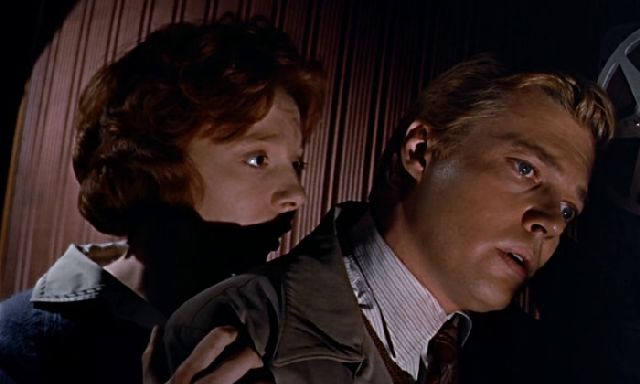Peeping Tom (1960) 
“WARNING! Don’t see Peeping Tom unless you are prepared to see the screaming shock and raw terror in the faces of those marked for death!”

Director: Michael Powell
Cast: Karlheinz Böhm, Anna Massey, Moira Shearer
Synopsis: A young man murders women, using a movie camera to film their dying expressions of terror.
Michael Powell’s Peeping Tom is one of a handful of landmark films by which the history of cinema can be charted. Its own history is well-documented. Considered irredeemably depraved and disgusting upon its release, the movie scuppered Powell’s career in the UK and was quickly withdrawn from circulation because of the media outcry. Almost forgotten until the 1970s, Peeping Tom’s fortunes were revived by the championing of Martin Scorsese, and today it is considered a classic. Released in the spring of 1960, it was certainly ahead of its time. It was misunderstood and feared not only because it chose to show a psychopathic killer in a sympathetic light but because it suggested his condition was essentially the consequence of the universal desire to watch the lives of others — as displayed by our fascination with movies — taken to its logical extreme. Peeping Tom’s Mark Lewis was nothing more than a distorted reflection of the movie’s audience, and like one of his victims forced to witness their own murder in the parabolic mirror attached to his camera, the audience squirmed and writhed…
Lewis is played with studied diffidence by Austrian actor Karl Boehm. He works as a focus puller at a film studio and lives in a large house. The house belonged to his father (played by Michael Powell), an eminent scientist involved in the study of fear, but Mark has been forced to let many of its rooms in order to pay for its running costs. He occupies just a couple of upstairs rooms and, as Helen Stephens (Anna Massey), the girl downstairs with whom he begins a tentative relationship, observes, he ‘walks around as if he can’t pay the rent.’ He’s a quiet, unassuming chap, and quite good looking — but he’s also deeply disturbed thanks to having lived his childhood under the constant gaze of his father, who conducted psychological experiments on his young son in an attempt to gain a better understanding of the nature of fear.
Peeping Tom opens with the close-up of an eye before assuming the viewpoint of the killer — or at least of the camera he has hidden beneath his duffel coat — as he approaches a cheap prostitute. The height of the camera is all wrong, filming from eye-level instead of chest- or lower, but it’s necessary in order to get a decent view of the murder that takes place after the killer has followed her to her room. The camera slowly closes in on the woman after she pauses while removing her clothes to gaze at the camera with a mild curiosity that soon turns to terror. With this simple opening, Michael Powell establishes an uncomfortable intimacy between the killer, his victim and the audience.
Powell compounds this identification with Boehm’s psychopathic killer by portraying Mark Lewis as an outwardly ordinary, if shy and reclusive, young man who is tormented by — and powerless to resist — a compulsion which has its roots in the cruel treatment of his father — who is the real monster in this movie. As Lewis begins to trust Helen, he screens for her movies made by his father in which we see him awoken in the middle of the night by a lizard thrown onto his bed so that his father can record his terrified reaction. It’s a brilliant piece of manipulation by Powell and screenwriter Leo Marks, stirring conflicting emotions towards Lewis of pity and revulsion, and one can’t help wondering whether it was this near-inexplicable duality of emotions that enraged those long-ago critics so. Never before had a movie so deftly toyed with its audience.
Peeping Tom is over half a century old now, though, and tastes change. There’s no doubt it was light years ahead of its time, but it was also of its time, a fact which is reflected in the way that Lewis’s condition isn’t explored as graphically as it could have been if the movie had been made just a decade later. There are tantalising glimpses here and there, hints and clues that sometimes leave us wishing for more detail on Lewis’s descent into insanity because, by the time we meet him, he’s already mad, and the old home movies he shows Helen provide only the sketchiest of detail.
Nevertheless, Lewis still comes across as a disturbingly plausible madman, functioning in a world which is incapable of even recognising his problems, and it’s this subtlety of character that sets Peeping Tom apart from all the serial killer movies that can trace their origins to it. There’s someone like Mark Lewis in every city in the world, and the truly terrifying thing is that we’re incapable of identifying them until after they committed an atrocity.
(Reviewed 12th February 2014)
httpv://www.youtube.com/watch?v=nAqEn6JS-oM
